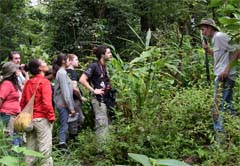How to save the planet: Facing Climate Change through the approach of Analog Forestry
Leonardo DiCaprio’s documentary „Before the Flood“ clarifies that Climate Change is no more a scenery of the future. The movie shows Miami fighting with rising sea levels and monsoon rains in India destroying harvests in only half a day. Also, Costa Rica records extreme weather conditions.
According to the Tico Times Guanacaste experienced “a historically bad drought” with almost life risking results in 2015. The consequences of human mismanagement of natural resources are coming to light at this very moment. Media reports about global warming all over the world show: If we don’t start to rethink our habits, there is no guarantee that our children will get to know the earth the way we know it. Science proves that thousands of species are exterminated every year through human influences. Less butterflies, bees, tigers, elephants and flowers.
In the future, a lot of flora and fauna are going to be vanished. But saving biodiversity is not only wishful thinking. Biodiversity is also the guarantee of humankind’s survival. The big question is: how can we manage to get out of this cul-de-sac? What can be a basis to build on?

Studious participants learning more about Analog Forestry from Instructor Milo at the Finca Fila Marucha
One answer lies in the idea of agricultural food production à la Analog Forestry (AF). On our journey to find out more about this concept we travelled to Milo Bekin’s Finca Fila Marucha and Analog Forestry training center in Londres de Aguirre. Hidden between dense foliage, surrounded by birds, reptiles and colorful insects Milo is carefully pollinating a yellowish vanilla flower. “If you are fast enough you can pollinate hundreds of flowers in a day”, he explains proudly.
He is one of the founders of AF which is understood as “an approach to ecological restauration which uses natural forests as guides to create ecologically stable and socio-economically productive landscapes.” Furthermore, this holistic methodology postulates the reduction of external foreces such as agrochemicals. Moreover, AF is an alternative to destructive agroforestry and promises economic stability to the producers. Consequently, a designed food forest creates a favor to biodiversity, proves itself as economically attractive while underlining social and cultural development.
The paradigm’s success is embodied in the fact that AF has representatives all over the world. Organized as the International Analog Forestry Network (IAFN), certified and experienced trainers are dedicated to instruct all interested parties from students, to governmental officers and farmers. The four training centers in Bolivia, Sri Lanka, Cameroon and Costa Rica also provide information on national and international certification of forest grown products. The most important principle of organic and agroforestry production in terms of AF is the imitation of the existing forest.
In 1982 one of the founders of IAFN Dr. Ranil Senanayake formulated the methodologies and principles of AF. The concept was so successful that the International Federation of Organic Agriculture Movements (IFOAM) adapted the Forest Garden Product (FGP) principles into their worldwide Family of Standards for food export in 2014. Regarding the Costa Rican training centers’ long term goals are the development of a national system of certification for AF producers for the national market called Participatory Guarantee System (PGS) along with the reinforcement of a Costa Rican network.
And even for those who don’t plan to grow food on a larger scale, AF provides tools for a healthy and self-sufficient lifestyle. A tableau vivant is Paulina Chaverri who is working for IAFN and lives in the mountains of Escazú with her own Forest Garden Eden. While 1/3 of her property consists of stable forest the other part provides space for bananas, kale, beans, lemons, tomatoes and all kinds of herbs and much more delicacies. As a trainer of permaculture, she is convinced that everyone has the ability to start growing their own food. Even one tomato tree on the balcony is a step in the right direction. Can this be a possible way out of Climate Change?
In “Before the Flood” Leonardo DiCaprio says he is more than pessimistic about our planet’s future but learning more about AF gives us hope that there is no need to cut down the lungs of our planet. Analog Forestry shows how we can live in harmony with nature respecting biodiversity and securing our existence. If we start to practice the principles now, we can eventually find a way out of the cul-de-sac.
Find out more about Analog Forestry and its principles: www.analogforestry.org/
 16-11-27 21:47:00,
16-11-27 21:47:00,
Neueste Kommentare